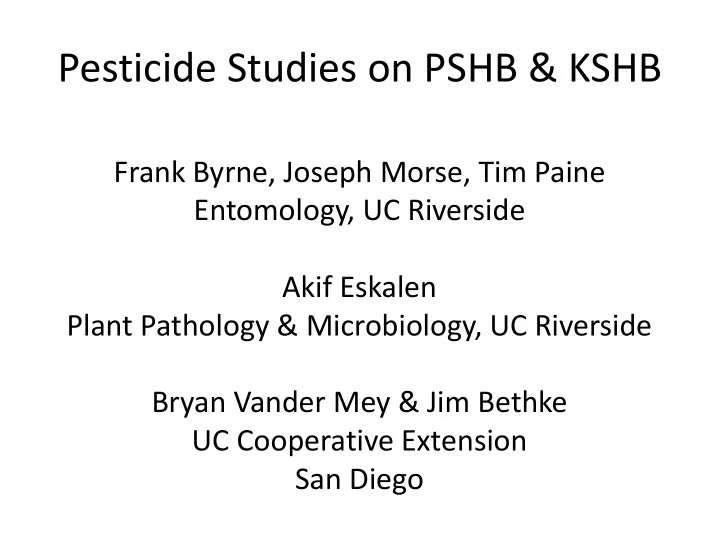

Pesticide Studies on PSHB & KSHB Frank Byrne, Joseph Morse, Tim Paine Entomology, UC Riverside Akif Eskalen Plant Pathology & Microbiology, UC Riverside Bryan Vander Mey & Jim Bethke UC Cooperative Extension San Diego
Pesticide Studies on PSHB & KSHB Prevention or Cure • There is no effective chemical treatment • for severely infested trees Data already available from other sources • Israel - Florida (redbay ambrosia beetle/laurel - wilt)
Systemic insecticides (mostly) tested against the larvae feeding on fungus growing on PDA with the incorporation of 10 ppm of the tested chemical Zvi Mendel, Dept. of Entomology, ARO, The Volcani Center; Bet Dagan, Israel
Pesticide Studies on PSHB & KSHB What are the options? • Surface/contact treatments (wood not foliar) - ∗ Prevent new infestations ∗ Manage newly emerging beetles ∗ Generally require multiple applications Sub-surface treatments (systemic) - ∗ Soil drenches for root uptake ∗ Inject material directly into trees ∗ Prevent new infestations ∗ Manage newly emerging beetles??
Current Pesticide Studies San Diego County - Escondido Grove • KSHB well established at this site - Mobile lab permits on-site bioassays - Priority to test chemicals to support Section 18 - registration for HERO EW as a persistent wood surface treatment against adults Section 18 of the Federal Insecticide, Fungicide, and Rodenticide Act (FIFRA) authorizes the EPA to allow an unregistered use of a pesticide for a limited time if the agency determines that an emergency condition exists
Current Pesticide Studies San Diego County - Escondido Grove • KSHB well established at this site - Mobile lab permits on-site bioassays - Priority to test chemicals to support Section 18 - registration for HERO EW as a persistent wood surface treatment against adults ∗ Bifenthrin (9.72%) and zeta-cypermethrin (3.24%) ∗ Currently registered insecticides for avocados (most unsuitable for use as wood treatments)
Hero Bioassays Bryan Vander Mey & Jim Bethke
Hero Bioassays
Hero Bioassays Note there is little change in beetle boring between 48h and 7d assessments • This indicates that the critical period for contact activity is within the first 48h of exposure • If insects don’t bore within 48h, then they die •
Hero Bioassays • Very high control mortality - Handling issues - Insect not well-adapted to local conditions • Importance of contact activity of Hero evident from 2 perspectives - High toxicity to beetles upon direct contact within 48h of exposure - Dramatic decrease in the number of bore holes present on the treated logs means Hero effectively reduces colonization - Key to success of any surface treatment is that it works within 48h Bryan Vander Mey & Jim Bethke
Current Pesticide Studies Ventura County - Pine Tree Ranch Trial • Started in January 2015 - Insecticide and fungicide evaluations - TREE-age (Arborjet formulation of emamectin - benzoate; 4%)
Emamectin Benzoate • Avermectin family • Macrocyclic lactone • Cl - channel activation (GABA & glutamate)
Systemic insecticides (mostly) tested against the larvae feeding on fungus growing on PDA with the incorporation of 10 ppm of the tested chemical Zvi Mendel, Dept. of Entomology, ARO, The Volcani Center; Bet Dagan, Israel
Current Pesticide Studies Ventura County - Pine Tree Ranch Trial • Started in January 2015 - Insecticide and fungicide evaluations - TREE-age (Arborjet formulation of emamectin - benzoate; 4%) Label: 2 years of control of Ambrosia beetles - NOT registered for use on commercial avocados - Collecting data in support of IR-4 application - ∗ Field data ∗ Lab-based bioassay data using Stouthamer saw dust diet (UCR quarantine)
Current Pesticide Studies Ventura County - Pine Tree Ranch Trial • Neat vs Diluted TREE-age (same a.i. amount) - Neat injected with Quikjet Air - Diluted injected with Tree IV system - Fruit residue work completed (dilute - treatments only were tested) Emamectin also injected with Propizol - Treatment Emamectin Emamectin + Propiconazole 1 Month 0.003 ppm 0.002 ppm 3 Month 0.002 ppm 0.002 ppm
Lab-based bioassays will provide important information on what doses are effective against the PSHB and KSHB
In The Works Tilt Section 18 • Propiconazole - Already in the IR-4 program for avocados - 3 studies completed at the South Coast REC - Recently submitted wood core samples from - our Pine Tree Study and South Coast REC IR-4 Study for residue analysis ∗ Florida data shows Tilt moves very slowly within trees, but can provide up to 2 years control of the laurel wilt pathogen
Future Studies Emamectin benzoate formulations • 3 formulations will be compared - October 5, 2015 - Rates of injection - ∗ Efficacy ∗ Persistence ∗ PHI Mode of injection • Arborjet v Sidewinder - San Diego and Ventura groves •
Future Studies Neonicotinoid formulations • 2 formulations will be evaluated in the - October trials San Diego and Ventura groves - Neonicotinoid injections proved effective • against avocado thrips and avocado lace bug Leaf residues only were measured - Rate of uptake was fast - too fast? - Timing of injections affected uptake -
Recommend
More recommend